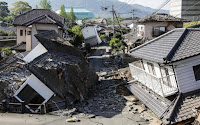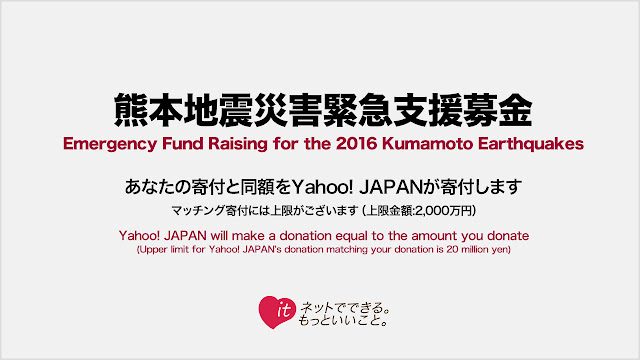More than 140 aftershocks were registered within two days of the foreshock with 11 aftershocks of at least M4.5 and one of M6.0.
The mainshock occurred at 1:25 am on April 16, 2016 beneath Kumamoto City in Higashi Ward. The M7.3 quake has caused significant additional damage to the areas already affected by the initial foreshock several days earlier.
This is the worst humanitarian challenge Japan has faced since the 2011 Tohoku Earthquake and Tsunami. As of today (Thursday, April 21), there have been 48 confirmed deaths with thousands affected by the disaster. New reports have being saying that around 10,000 people are staying in their cars in Mashiki Town, while there are 180,000 evacuees seeking shelter.
There has also been 11 indirect deaths in Kumamoto related to the disaster. Quite a few people have been dying from the so-called "economy class syndrome" (Deep Vein Thrombosis) caused by sitting too long in cramped conditions in recuse shelters and from sleeping in cars.
 |
| Image Source |
Japanese Prime Minister Shinzo Abe has mobilized personnel of the Japan Self Defense Forces to assist local authorities with search and rescue recovery efforts. Japan is struggling to cope with the disaster with relief efforts stretched to the limit.
Nearly a week after the first quake struck, aftershocks continue with nearly 700 aftershocks hitting Kyushu since April 14. To further add to the disaster, heavy rain and wind is predicted the next few days with the possibility of landslides causing even more problems.
You can find news and updates about the Kumamoto Earthquakes on the Japan national Tourism Organisation website.
If you are interested in helping out and supporting the people and areas affected by the earthquakes, Yahoo Japan has set up emergency fund raising for the 2016 Kumamoto Earthquake. They will donate an equal amount to your donation (up to 20 million yen per donation). You can find more information on their website in both English and Japanese http://donation.yahoo.co.jp/detail/1630023/


